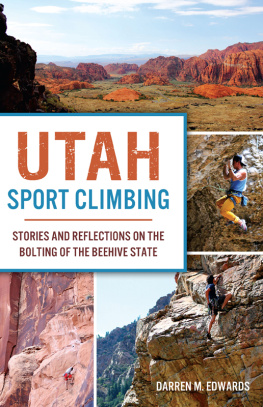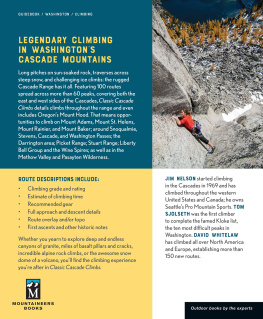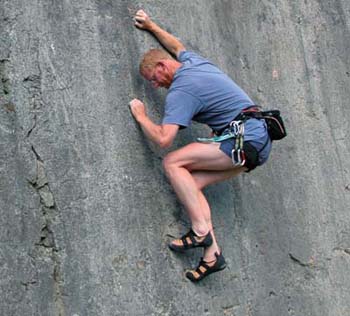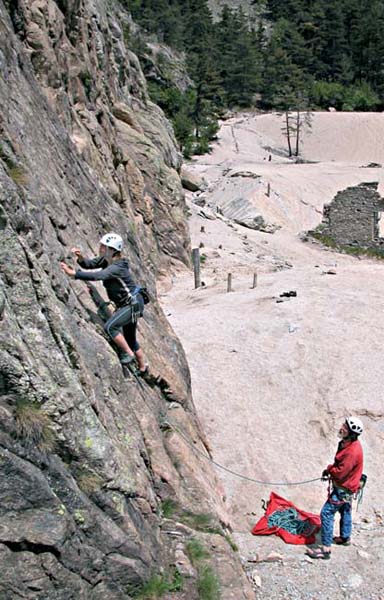The author on Alice, 7a, St George, Switzerland
Pete Hill MIC, FRGS has climbed in many continents and countries across the world, including first ascents in the Himalayas. He is a holder of the MIC award, the top UK instructional qualification, and has been delivering rock and mountain sports courses at the highest level for a number of years. He is a member of the Alpine Club, honorary life member of the Association of Mountaineering Instructors and a Fellow of the Royal Geographical Society. A lack of common sense has caused him to be found on the north faces of the Eiger and Matterhorn in winter, as well as on a number of other extreme routes climbed in difficult conditions in the European Alps, Africa, Nepal and India. He spends a lot of time travelling to European sport-climbing venues in search of sunshine and the ultimate route.
Pete lives in Scotland and has two daughters, Rebecca and Samantha. A frequent contributor to various magazines and websites, he is also author of The International Handbook of Technical Mountaineering and Rock Climbing: Introduction to essential technical skills , and co-author (with Stuart Johnston) of the globally successful The Mountain Skills Training Handbook . He runs both summer and winter skills courses from beginner through to advanced level, and can be contacted via his website at www.petehillmic.com.
SPORT CLIMBING
TECHNICAL SKILLS FOR CLIMBING BOLTED ROUTES
by
Pete Hill MIC, FRGS
2 POLICE SQUARE, MILNTHORPE, CUMBRIA LA7 7PY
www.cicerone.co.uk
Pete Hill 2007
ISBN-13: 978 1 85284 528 5
A catalogue record for this book is available from the British Library.
Acknowledgements
As always, Im indebted to friends, acquaintances and others who have eased the passage of this project through their unselfish help and support. Samantha Hill took the climbing photo on page 4, and Giles Stone is responsible for the one on page 65. For the Selected Sport-climbing Venues section, Jonathan Preston, Allen Fyffe and Rob Johnson kindly let me use some of their climbing photographs of Italy, the USA and Spain respectively, and Scott Muir endured my leaning over his shoulder to take photographs during a bolting expedition to crag x; my thanks to all of them. The topos in the guidebook section are taken with permission from the excellent Lescalade dans les Alpes-Maritimes , and I am grateful to Jean-Claude Raibaud and those involved in Alticoop for letting me do so. Giles and Fran Stone provided a base in the south of France for my climbing trips in the sun, loosely disguised as research; thanks are due to them for their hospitality and seemingly inexhaustible supplies of red wine. Equipment support was generously supplied by a number of companies, with particular thanks to Frank Bennett at Lyon Equipment (www.lyon.co.uk), Beal for the ropes and software (www.bealplanet.com), Petzl for the hardware used in photographs (www.petzl.com) and Faders for the excellent SUM (www.faders.es).
Finally, Paula Griffin once again burnt the midnight oil trying to make sense of my often illegible scratchings and for that as well as being the perfect climbing partner I am eternally grateful.
Note
To avoid confusion when describing sequences of moves involving a climber and second, the use of they has been avoided. Instead he is used to refer to the leader, and she to refer to the belayer/second.
Disclaimer
Whilst every effort has been made to ensure that the instructions and techniques in this book cover the subject safely and in full detail, the author and publishers cannot accept any responsibility for any accident, injury, loss or damage sustained while following any of the techniques described.
Front cover : Les Fees Meres, 6b, Saint-Jeannet, Maritime Alps
CONTENTS
Climbing Paracouerte, 4+, Bernard Gobbi, France
INTRODUCTION
Sport climbing has become phenomenally popular over recent years. From its early days when those drilling rock were castigated by traditional climbers, most now accept that sport climbing has its place alongside crags where leader-placed protection is the norm. The increase in personal leisure time and the explosion in low-cost air travel have done much to encourage the growth of the sport. Travel to some of the hottest cragging spots in the world is now possible at a fraction of the cost, in real terms, of 10 years ago.
Sport climbing differs from traditional climbing in that, generally, the protection used to safeguard the leader is already in place, in the form of bolts and rings drilled into the cliff. Unfettered by a large rack of wires, chocks and camming devices, the climber carries little more than a few extenders, and is free to climb fast and hard, pausing only briefly to clip the gear as he passes by. Climbers often find that they can climb far harder than their usual traditional leading grade, as the security of a well-bolted and user-friendly crag induces a relaxed atmosphere and thus an improvement in performance.
This style of climbing is often seen as having a minimalist approach, where extra kit often only comprises shorts, T-shirt and sunglasses. Although bolted routes are found the world over, it is this sunny aspect of many sport-climbing venues that is a great attraction to many. To be able to combine a climbing trip or holiday with some well-bolted sport routes somewhere with stable and predictable weather makes for an excellent change to what may otherwise be a mundane, workaday routine.
This book sets out the variety of skills needed to complete a bolted route safely. At many levels the skills base is low, and simply being able to belay and clip in an extender correctly, allied with the knowledge of how to organise a lower-off, will give a great day out. However, as grades and length of routes increase in particular when dealing with multi-pitch climbs it is essential to have more technical knowledge. This book will take you all the way from the basics, such as tying on and belaying, through the skills needed to climb safely on multi-pitch crags the world over.
Whatever your aspirations, make sure you have a good and safe time on the crag. Sport climbing is here to stay. Hopefully those who still see it as a dark art will change their opinion before long and realise that climbing, in all its forms, is big enough for everyone to have their own space, enabling us all to get on with what is important having fun.
1 BOLTS AND BOLTING
Well-placed close bolts
1 BOLTS AND BOLTING
A bolt is a generic, cover-all term used to describe a piece of metal protection fixed to a rock face. There are many different styles and types, and which one to use in any particular location will depend upon a number of factors. Rock type, location (coastal or inland), local ethics, type of climbing and the financial situation of the bolter all play a part.










